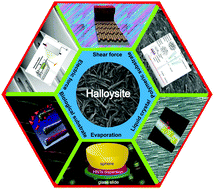Self-assembled structures of halloysite nanotubes: towards the development of high-performance biomedical materials
Abstract
Halloysite nanotubes (HNTs), 1D natural tubular nanoparticles, exhibit a high aspect ratio, empty lumen, high adsorption ability, good biocompatibility, and high biosafety, which have attracted researchers’ attention in applications of the biomedical area. HNTs can be readily dispersed in water due to their negatively charged surface and good hydrophilicity. The unique rod-like structure and surface properties give HNTs assembly ability into ordered hierarchical structures. In this review, the self-assembly approaches of HNTs including evaporation induced self-assembly by a “coffee-ring” mechanism, shear force induced self-assembly, and electric field force induced self-assembly were introduced. In addition, HNT self-assembly on polymeric substrates and biological substrates including hair, cells, and zebrafish embryos was discussed. These assembly processes are related to noncovalent interactions such as electrostatic, hydrogen bonding, and van der Waals forces or electron-transfer reactions. Moreover, the applications of self-assembled HNT patterns in biomedical areas such as capture of circulating tumor cells, guiding oriented cell growth, controlling cell germination, and delivery of drugs or nutrients were discussed and highlighted. Finally, challenges and future directions of assembly of HNTs were introduced. This review will inspire researchers in the design and fabrication of functional biodevices based on HNTs for tissue engineering, cancer diagnosis/therapy, and personal healthcare products.

- This article is part of the themed collection: Journal of Materials Chemistry B Recent Review Articles


 Please wait while we load your content...
Please wait while we load your content...